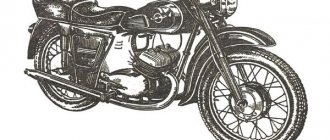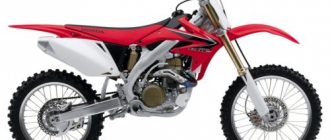The IZH motorcycle is a domestic vehicle that has shown its best qualities over the years. Models of the Izhevsk Machine-Building Plant were produced in a variety of classes. Among them were ordinary road ones for rural and urban areas, sports ones for racing competitions, some models were also produced for law enforcement agencies. Motorcycles of the state enterprise “Izhmash” are still very popular among the people to this day. IZH was nicknamed “donkey”. When purchased, it was mainly adapted for subsidiary farming. Craftsmen immediately appeared who remodeled the stroller, put a box on the chassis instead of the standard one, and loaded much more cargo into it.
History of IZH motorcycles
The history of serial production of IZH began in 1946. At that time, approximately 11 million motorcycles of various modifications were produced in the city of Izhevsk. The legendary IZH-49 was especially popular among the population at that time.
© Svetlana Siletskaya / Photobank Lori
Manufacturers included in the design a rear suspension with hydraulic shock absorbers and a telescopic front fork. IZH-49 was considered a comfortable vehicle, reliable and durable.
Not based on the IZH-49 model, the IZH-56 was developed and released in 1956.
Subsequently, in 1962, based on the IZH-56, a new model, the IZH Planet, was put into production.” On the basis of IZH-56, in 1957, sports motorcycles with tubular frames and pendulum suspensions began to go into production. Such modifications include: - IZH-57-K - intended for cross-country racing, engine power 18 hp; — IZH-57-M — 18 hp, intended for multi-day competitions; - IZH-54-A - 20 hp power, rear wheel 16 (size in inches), and front wheel 19 (size in inches), intended for road racing competitions; — IZH-60-M — intended for multi-day competitions, engine power 19 hp; — IZH-60-MS was also intended for multi-day competitions, power 19 hp, equipped with a six-speed gearbox. Later, other modifications of IZh motorcycles began to be developed: IZH-Jupiter, IZH-Planet Sport and others.
Repair and tuning
Repair
Over the long period of production, the IZH Planet-5 motorcycle has acquired a large army of fans who have developed methods for repairing and modernizing almost any module.
The motorcycle has clearly established itself as an unpretentious vehicle. However, it had to be repaired quite often, although this does not require special skills. It's all about the resource of spare parts and improper care of the motorcycle. Often the motorcycle is used in rural areas without an air filter and with low-quality oil. So for fans of this technology, it will not be a surprise to replace the piston once a season.
In the first models, the malfunction of the motorcycle's electrical circuit progressed, which consisted mainly of poor-quality terminal connections and oxidation of the battery contacts. Therefore, popular technical magazines of those years quickly published the electrical circuit diagram of the IZH Planet-5 motorcycle.
Electrical circuit of Izh Planeta 5.
The design of the model itself was not particularly intricate or complex, which allowed even a non-specialist to understand its structure.
Read other motorcycle reviews Review of the Minsk S4 250 motorcycle
Electrical diagram
Spare parts
The motorcycle is unpretentious and does not require close attention. The main complaints are caused by the poor quality of the batteries and the rapid failure of the ignition switch. But, despite the fact that the model has not been produced for more than 7 years, spare parts are available to the average owner. Thus, the website zapchasti-izh.ru presents a wide list of parts necessary for repairs of any complexity. For example, an ignition switch costs about $2.
Tuning
An army of fans of the reliable IZH Planet-5 motorcycle model tried in every possible way to change its appearance in order to stand out from the crowd and adapt it as much as possible to their taste:
IZH is a cool sportbike
Izh "Planet-5". There's something about him
Izh - Bandit.
Made from the Planet ATV
Converting Izh into a sportbike.
"Minsk M1A". First Belarusian
To this day, the “Minskachi” remains the most “popular” motorcycle in Belarus. They run along the roads of the entire former Union, and not only. But most of them, of course, are in their homeland.
Minsk motorcycles passed their half-century anniversary a long time ago (the first models already fully deserve the name “vintage”), and very soon, on July 12, they will celebrate their 61st birthday.
The first Belarusian “bike” was the Minsk M1A, which had many “relatives” not only in the USSR, but also abroad. The “ancestor” of the motorcycle was developed in 1939 by the Germans. The DKW RT125 turned out to be so successful that analogues of this motorcycle were produced under different names in 7 countries around the world, including the USA, England and Japan.
By the way, one of the old “Minsk racers” was tested in harsh conditions by one of the hosts of the famous British show Top Gear, Richard Hammond. He drove it from south to north almost all of Vietnam. CV of the charismatic “car maniac”: “This is the AK-47 among motorcycles - reliable, simple, easy to repair. It was made specifically for those countries where there are no roads.”
"PMZ-A-750"
In 1931, the development of medium and heavy motorcycles for the army and the national economy began. The first was the heavy motorcycle “NATI-A-750”. This car was a mixture of traditions: an American-type power unit was built into the chassis, made in the image of a BMW. “PMZ-A-750” was used not only in the army, NKVD units, but also in the civil service. The design of the motorcycle turned out to be durable, but very capricious. As a joke, the letters PMZ were deciphered as “Try to turn me on.”
Power transmission
Double-row bushing chain Gear ratio from the engine to the clutch - 2.17 Clutch - multi-plate in an oil bath Gearbox - four-speed From the gearbox to the rear wheel - closed bush-roller chain Gear ratio from the gearbox to the rear wheel - 2.33 Shift - foot lever Gearboxes box ratio: at first speed - 3.17 at second speed - 1.81 at third speed - 1.26 at fourth speed - 1.0 General gear ratios: at first - 16.03 at second - 9.16 at third - 6.37 in fourth gear - 5.05.
Back to contents — ↑
ZID-175 4ShP. The first Soviet ATV.
Surprisingly, in our country, despite the complete absence of roads in some places, ATVs have never been mass produced. Almost the only more or less serial copy was the ZID-175 4ShP, produced at the Dyagterev Plant.
The design was not very successful: weak engine, complex transmission elements. This is probably why such ATVs are not widely used.
Advantages and disadvantages
pros
- Comfortable fit.
- Good maneuverability.
- Unpretentiousness.
- Price.
- Repairability.
Minuses
- Small resource.
- Noisy engine.
- Toxic engine.
- Outdated model.
- Tight clutch.
- Vibrations.
- Motorcycle weight.
The main disadvantage of the model is the ill-conceived electrical supply system. The maximum voltage that the generator develops at a power of 350 W and high engine speeds reaches 30 V, which is quite enough to damage the battery charging system.
Vyatka VP-150. Italian elegance.
The last one in our review is not a motorcycle at all, but a scooter.
The Vyatka VP-150, the prototype of which was the Italian Vespa scooter, is rightfully considered the most elegant two-wheeled vehicle in the USSR. It was a quiet and very comfortable scooter that even women could drive with ease. At the Vyatka base they made a whole range of three-wheeled scooters with various bodies, which were actively used in urban cargo transportation.
Adjustment data in millimeters - mm
Gap between breaker contacts - 0.4 - 0.6 Gap between spark plug electrodes - 0.6 - 0.75 Free play at the end of the clutch lever - 5 - 10 Free play at the end of the handbrake lever - 10 - 20 Free play at the end foot brake lever -10 – 25 Free play of throttle and corrector cables – 1 – 2 Ignition timing to t.m.t. — 3.0 — 3.5 Rear wheel drive chain slack — 20 — 30 Air pressure in tires, MPa: front — 0.15+0.01 rear — 0.21+0.01.
Back to contents — ↑
M-1A "Moscow"
Let's try to build this excursion into the motorcycle past of a great country in chronological order. Let's take the post-war period, well, simply because it is clearer and closer to us.
The motorcycle industry was revived on the basis of the best examples of captured equipment. And a lot of it was brought to the USSR. And now at the Moscow Bicycle Plant they are mastering the production of a copy of the German motorcycle DKW RT125 with a 125 cc engine.
The device is called M-1A “Moscow”. This is the first post-war motorcycle of the USSR - simple and lightweight, which did not require a lot of metal and rubber.
Motorcyclists were trained on this type of equipment in DOSAAF schools. In 1951, production was transferred to Minsk to a newly built bicycle plant. Almost the same model with the index K-125 was produced in Kovrov.
L-300 "Red October". The very first.
The very first serial Soviet motorcycle was the L-300 “Red October”.
At the beginning of 1930, Leningrad designers prepared its drawings, inspired by the most reliable bike of that time - the German DKW Luxus 300. And in the fall of the same year, the first batch of L-300 was ready.
The motorcycle was produced until 1938, and then the no less legendary IZH-8 was created on its basis. This “descendant” of the L-300 even ended up on silver coins... in New Zealand.
By the way, the name IZH-7 was borne by the same L-300s, which were produced in Izhevsk in parallel with the Leningrad enterprise “Red October”.
M-72. The most combative
The M-72 was not the first army motorcycle in the USSR. In 1934, the assembly of the first Soviet heavy model PMZ-A-750 began, and in 1939 - the “understudy” of the British BSA and, considered to be the best pre-war motorcycle in the Union, TiZ-AM-600.
However, it was the M-72, the design of which was “spiked” from the German BMW R71 (the Wehrmacht was equipped with them), which came out in the tragic year of 1941, and was produced throughout the war. And then they seriously served the people for civilian purposes - the last copies rolled off the assembly line in 1960. From 1941 to 1945, the M-72 carried soldiers armed with anti-tank missile systems, machine guns or light mortars. From the first post-war years - and long after - these motorcycles became the main police transport. And since 1954, ordinary Soviet citizens could buy them for their needs.
“Descendants” of the M-72 were ordered by Saddam Hussein’s Republican Guard at the beginning of the 2000s. But I didn’t have time to use it, and combat motorcycles “went to the people.” At the request of customers, Iraqi auto repair shops install additional “active and passive protection” on the Urals - armor and a machine gun.
"Tula-200"
In 1986 - 1988, a very unusual motorcycle, the Tula-200, was produced in the Soviet Union, which was distinguished by wide off-road wheels. They were needed because the model was intended for hunters and fishermen.
They took the engine from the Tulitsa scooter, boosting it to 13 hp. This made it possible to accelerate to 90 km/h, although for such a device speed was not the main indicator; cross-country ability was much more important.
10,000 -12,000 thousand of these bikes were produced per year. The last one rolled off the plant's assembly line in 1996.










